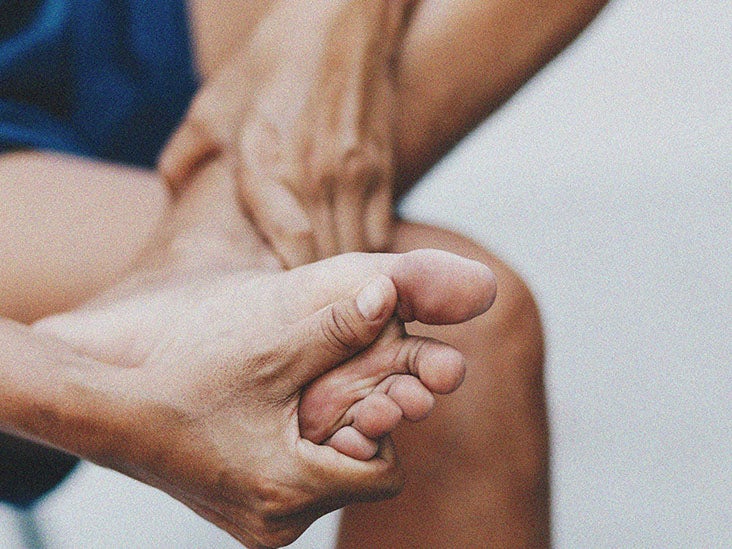
The location of pain in the foot can sometimes indicate the underlying cause. The cause will determine whether medical treatment is necessary.
Foot pain is common as it has a wide range of contributing factors, including uncomfortable shoes, too much time standing, athletic injuries, and chronic conditions, such as arthritis.
Some studies suggest that nearly 1 in 4 people have frequent foot pain in midlife.
The specific location of the pain can sometimes be helpful in determining the cause.
However, it is not always possible to diagnose the cause of foot pain based on location. Many conditions, such as arthritis, can affect several different parts of the foot. Injuries, such as a broken bone, sprain, or strain, may also cause general pain or pain that migrates.
This article explores the likely causes of foot pain based on its location in the foot. It also explains when to consult a doctor.
Generalized pain in a single toe may be due to a hammer toe.
Hammer toe is a deformity that affects the second, third, or fourth toe.
The affected toe bends downward and appears misshapen. The toe may appear swollen or discolored, and a person might not be able to straighten it. Sometimes, hammer toe affects multiple toes.
A hammer toe happens when there is an imbalance in the muscles, which often results from frequently wearing shoes that do not fit correctly or high heels.
Muscle-strengthening exercises and changing to more comfortable shoes may help.
However, if the hammer toe does not resolve on its own, a person might need surgery.
Pain in the joints — such as on the knuckles of the toes, in the ankle, or at the point where the toes connect to the foot — may warn of arthritis.
Arthritis refers to a group of illnesses that affect the joints. The most common type is osteoarthritis, which happens when the cartilage that cushions the joints deteriorates.
Although there is no cure for arthritis, various treatments can help.
Treatment options include pain medication, physical therapy, exercise, arthritis medication, corticosteroid injections, and, sometimes, surgery to replace damaged joints.
Osteoarthritis in the foot most commonly affects the big toe.
Many of the same conditions that affect the toes generally, such as broken bones, strains, sprains, and arthritis, can cause big toe pain.
However, if the pain is only in the big toe, and the top of the toe hurts most, the problem may be an ingrown toenail.
An ingrown toenail happens when the side edge of the toenail grows into the skin. This can be painful and may cause an infection or swelling. In some cases, it may hurt to walk on the affected foot.
When checking for an ingrown toenail, a person should look for swelling on one side of the toe, as well as pain when pushing on the toenail.
It is important not to dig into the nail bed with scissors to cut out an ingrown nail. Instead, a person should visit a doctor, who can remove an ingrown portion of the nail or offer antibiotics to treat an infection.
People can prevent future ingrown nails by avoiding cutting the toenails very short or at an angle.
Pain in the ball of the foot, or at the front of the foot near the toes, has many potential causes.
Muscle strains and sprains, minor overuse injuries, and tense muscles can all cause pain on the ball of the foot. This pain usually resolves within a few weeks, and it may get better with massage.
Several chronic conditions can also cause pain at the front of the foot.
Freiberg’s disease
A rare condition called Freiberg’s disease, which usually appears in the teenage years, involves a reduced blood supply to the foot around the second or third metatarsal bones near the toes. Symptoms include swelling, pain, and stiffness at the front of the toes. It usually only affects one foot.
Medication and physical therapy can reduce pain and improve mobility. If these are ineffective, a doctor may recommend surgery.
Morton’s neuroma
Morton’s neuroma is nerve pain from a benign tumor. A person may feel burning pain in the ball of the foot or in the toes.
Sometimes, there is numbness or tingling in the toes. Morton’s neuroma is not cancer, and a person will not feel a bump or other signs of a tumor.
Changes in footwear, cortisone injections, physical therapy, and pain medication offer relief to most people. If these do not work, a doctor may recommend surgery to repair the nerve.
Injuries to the muscles and tendons of the foot, unsupportive shoes, and overuse may cause pain in the arch of the foot.
Conditions that affect the heel, such as plantar fasciitis and tendinitis, may also cause foot arch pain.
For some people, fallen arches cause foot arch pain. People usually have fallen arches, or flat feet, when the tendons that support the arch of the foot weaken.
Doctors call this posterior tibial tendon dysfunction. Physical therapy, medication, injections, and, in some cases, shoe inserts may help.
Many conditions, including injuries to the ankle or surrounding joints, can cause pain that radiates to the heel. Plantar fasciitis and achilles tendinitis are among the most common of these conditions.
Achilles tendinitis happens when the tendon that extends down the back of the leg develops inflammation. This inflammation can be due to tight calf muscles, a calf injury, an increase in activity, or bone spurs.
Most people notice pain that is more severe in the morning and swelling that worsens with activity.
Various treatments can help with the pain, including physical therapy, cortisone injections, rest and ice, exercise, and pain medication.
Rarely, a person may need surgery. In most cases, symptoms get better within 3 to 6 months of beginning treatment.
Plantar fasciitis is inflammation of the plantar fascia, which is a thick band of tissue that extends from the heel to the toes. The pain is sharp and stabbing, often feeling worse in the morning or when beginning exercise.
Plantar fasciitis is more common in runners, people who do not wear supportive shoes, and those with overweight.
Spending long periods on the feet may also increase the risk of developing plantar fasciitis.
Most people recover within a few months by resting, icing, and stretching the affected foot.
A doctor may also recommend physical therapy or cortisone injections. Rarely, a person may need surgery to repair the plantar fascia.
Generalized foot pain or swelling may indicate a blood flow issue.
Damage to the nerves or blood vessels from conditions such as diabetes may cause swelling.
Sometimes, people’s feet temporarily swell in the heat. People may also notice swelling during pregnancy.
Unless the pain is intense, or a person has a high risk of conditions such as heart failure, swelling in the feet is not usually an emergency.
However, a person should contact a doctor right away if:
- one foot swells, and there is calf pain
- the feet swell suddenly and dramatically
- a person feels short of breath and has swelling or pain
It is best to speak with a doctor about foot pain if:
- it does not get better with home treatment
- it gets worse following surgery
- there is a family history of arthritis
Foot pain can make walking, sleeping, and daily tasks very painful. In severe cases, these activities may even be impossible.
Various treatment and management options are available, even for serious and chronic cases.
A person with persistent foot pain should not attempt self-diagnosis. Instead, they should see a doctor for a proper diagnosis and, if necessary, a treatment plan.
January 25, 2021 at 03:00PM
https://ift.tt/3qR6C4E
The causes and treatment of foot pain, based on location in the foot - Medical News Today
https://ift.tt/3ivRO87
High Heels

No comments:
Post a Comment